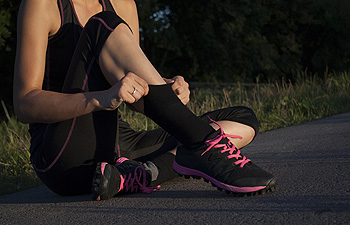 Although the movements of walking and running are similar, the areas of the body affected and the force of impact vary. When running, more force is exerted from the knees, ankles, and hips, with far greater impact than walking. Also, the heel, mid-foot, and toes bear the heaviest weight load as they strike the ground during running, while walking tends to distribute weight more evenly across the foot. All of these factors dictate that different types of shoes and levels of support are necessary for running versus walking. A good running shoe will have more cushioning than is necessary in a walking shoe, with a heel that is flared and raised higher than the toe. Running shoes are not as flexible as walking shoes, with most flexibility occurring in the arch and middle of the foot, whereas a good walking shoe will have more flexibility overall and particularly in the front of the foot to enable a powerful push-off. The heels on walking shoes should not be flared or much higher than the toes at all. A podiatrist can offer more specific criteria on footwear for runners and walkers to achieve peak performance and reduce the risk of injury.
Although the movements of walking and running are similar, the areas of the body affected and the force of impact vary. When running, more force is exerted from the knees, ankles, and hips, with far greater impact than walking. Also, the heel, mid-foot, and toes bear the heaviest weight load as they strike the ground during running, while walking tends to distribute weight more evenly across the foot. All of these factors dictate that different types of shoes and levels of support are necessary for running versus walking. A good running shoe will have more cushioning than is necessary in a walking shoe, with a heel that is flared and raised higher than the toe. Running shoes are not as flexible as walking shoes, with most flexibility occurring in the arch and middle of the foot, whereas a good walking shoe will have more flexibility overall and particularly in the front of the foot to enable a powerful push-off. The heels on walking shoes should not be flared or much higher than the toes at all. A podiatrist can offer more specific criteria on footwear for runners and walkers to achieve peak performance and reduce the risk of injury.
For more information about walking shoes versus running shoes, consult with Richard M. Allen, DPM from Idaho. our doctor can measure your feet to determine what your needs are and help you find an appropriate pair of footwear.
Foot Health: The Differences between Walking & Running Shoes
There are great ways to stay in shape: running and walking are two great exercises to a healthy lifestyle. It is important to know that running shoes and walking shoes are not interchangeable. There is a key difference on how the feet hit the ground when someone is running or walking. This is why one should be aware that a shoe is designed differently for each activity.
You may be asking yourself what the real differences are between walking and running shoes and the answers may shock you.
Differences
Walking doesn’t involve as much stress or impact on the feet as running does. However, this doesn’t mean that you should be any less prepared. When you’re walking, you land on your heels and have your foot roll forward. This rolling motion requires additional support to the feet.
Flexibility – Walking shoes are designed to have soft, flexible soles. This allows the walker to push off easily with each step.
If you have any questions, please feel free to contact our office located in Lewiston, ID . We offer the newest diagnostic and treatment technologies for all your foot care needs.
